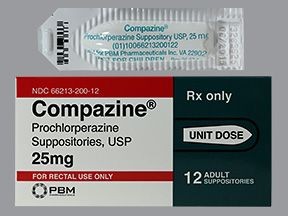
Contents
prochlorperazine (Compazine, Compro)
Prochlorperazine is an antiemetic and antipsychotic agent. It is one of the older first-generation piperazine phenothiazine antipsychotic medications. Examples of other phenothiazines include:
- fluphenazine (Permitil, Prolixin)
- chlorpromazine (Promapar, Thorazine)
- perphenazine, trifluoperazine (Stelazine)
- thioridazine (Mellaril)
The exact mechanism of phenothiazine antipsychotics is unknown. Scientists believe that they work by blocking the action of dopamine in the brain. Phenothiazine antipsychotics are used when other antipsychotics have not been effective.
Prochlorperazine controls nausea and vomiting by blocking dopamine in the chemoreceptor trigger zone of the brain. It also has effects on other neurotransmitters and receptors. Blockade of alpha-adrenergic receptors causes drowsiness, muscle relaxation, and adverse cardiovascular effects such as low blood pressure, reflex tachycardia, and changes in heart rhythm.
Prochlorperazine was approved by the US Food and Drug Administration (FDA) in 1956.
What brand names are available for prochlorperazine?
Is prochlorperazine available as a generic drug?
Do I need a prescription for prochlorperazine?
What are the side effects of prochlorperazine?
Side effects associated with prochlorperazine treatment include:
- Drowsiness
- Dizziness
- Amenorrhea (absence of menstruation)
- Blurred vision
- Skin reactions
- Low blood pressure
Movement disorders, cardiac, and liver abnormalities have also occurred in some patients.
Children are more prone to develop movement disorders than adults.
QUESTION
Which drugs or supplements interact with prochlorperazine?
- Acetylcholinesterase inhibitors may decrease the effectives of prochlorperazine. Combining prochlorperazine with alcohol, kava kava, CNS depressants, and cannabis may increase the risk of CNS depressant side effects.
- Antacids may decrease the absorption of prochlorperazine.
- Prochlorperazine may cause anticholinergic side effects. Combining agents with similar anticholinergic effects increases the risk of such adverse events.
- Prochlorperazine may increase the blood levels of dofetilide (Tikosyn). Use of both drugs is not recommended.
- Deferoxamine (Desferal) may increase the risk of side effects of prochlorperazine treatment.
- Metoclopramide (Reglan) may increase the side effects of antipsychotic agents. Combination use is not recommended.
- Prochlorperazine may increase the CNS depressant effects of orphenadrine (Norflex) or paraldehyde (Paral). Combination use is not recommended.
- Combining prochlorperazine and potassium chloride may result in an increase in the ulcerogenic effect of potassium chloride (Klor-Con). Combination use is generally not recommended.
- Combining prochlorperazine with thalidomide (Thalomid) may increase the risk of CNS depressant side effects. This combination is generally not recommended.
Is prochlorperazine safe to take if I’m pregnant or breastfeeding?
Prochlorperazine should be avoided in pregnancy except in cases of severe nausea and vomiting that requires treatment and potential benefit justifies the potential risk to the fetus. It should be used cautiously in nursing females.
What else should I know about prochlorperazine?
What preparations of prochlorperazine are available?
- Prochlorperazine Edisylate solution for injection: 5 mg/ml
- Prochlorperazine Maleate oral tablet: 5 mg, 10 mg
- Prochlorperazine rectal suppository: 2.5, 5, 25 mg
How should I keep prochlorperazine stored?
Prochlorperazine injection solution is recommended to be stored below 30 C (86 F). All other dosage forms may be stored between 15 C to 30 C (59 F to 86 F).
Adult dosing
Treatment of severe nausea and vomiting
- The dosage must be adjusted based on individual patient response.
- Patients are generally started on the lowest recommended dosage.
- Oral tablets: The usual recommended dose is one 5 mg or 10 mg tablet orally 3-4 times daily.
- Rectal suppository: 25 mg twice daily.
- Intramuscular injection: The usual starting dose is 5 to 10 mg injected deeply into the upper outer quadrant of the buttock. Additional doses may be given every 3 or 4 hours as necessary. Total daily dose should not exceed 40 mg per day except in resistant patients.
- Intravenous (IV) dosage: The usual recommended dose is 2.5 to10 mg by slow IV injection or infusion at a rate not to exceed 5 mg per minute. A single dose should not exceed 10 mg. The total daily dose should not exceed 40 mg per day.
Adult surgery patients with severe nausea or vomiting
- The total daily dose should not exceed 40 mg per day.
- Intramuscular injection: The usual recommended dose is 5 to 10 mg, 1 to 2 hours before the administration of anesthesia. A second dose may be given in 30 minutes if necessary. Repeat doses may also be given to control acute symptoms during and after surgery as needed.
- IV dosage: The usual recommended dose is 5 to 10 mg as a slow IV injection or infusion 15 to 30 minutes before the administration of anesthesia, or to control acute symptoms during or after surgery.
Adult psychiatric disorders
- Individual patient dosage is adjusted based on response and severity of the condition.
- Oral dosage: non-psychotic anxiety: The usual recommended dose is 5 mg 3-4 times daily.
- Psychotic disorders including schizophrenia (mild): The usual recommended dose is 5 to 10 mg 3-4 times daily.
- Psychotic disorders including schizophrenia (moderate to severe conditions): The recommended usual starting dose is 10 mg 3-4 times daily. Dosage should be increased in small increments every 2-3 days. Some patients may have a satisfactory response to 50 to 75 mg per day. Patient with severe symptoms may require 100 to 150 mg per day.
- Intramuscular dosage: For the immediate control of severe schizophrenia symptoms in adult patients, an initial dose of 10 to 20 mg administered deeply into the upper outer quadrant of the buttock may be given. Repeat injections may be given every 2 to 4 hours if necessary.
Pediatric use
Pediatric use is weight-based and the drug should not be used in children under 2 years old.
Summary
Prochlorperazine (Compazine, Compro) is an antimetic drug used to treat nausea and vomiting, as well as manage schizophrenia and non-psychotic anxiety. Side effects, drug interactions, dosing and storage information, and pregnancy safety should be reviewed prior to taking this medication.


